When thinking about the top clubs in women’s football, the first two that come to mind are Olympique Lyonnais and VfL Wolfsburg. The two sides have sat at the summit of European football for years now. However, Lyon has had the better of their German counterparts. Wolfsburg have been dumped from the UEFA Women’s Champions League in the past four years running. Two quarter-final exit and two final defeats – both of which went to at least extra time – have left Wolfsburg beaten and well behind their European rivals.
In this tactical analysis, we are going to take an in-depth look into the German champions. We will begin by looking into the principles of their offensive and defensive tactics, before then moving into looking specifically at two matches between the two sides. The first being the 2018 Champions League final where Lyon came out on top 4-1 after extra-time, and the second one being the 2019 quarter-finals first leg where Lyon were victorious 2-1. After looking at Wolfsburg’s shortcomings against Lyon, this analysis will identify areas in which they can close the gap and look to get the better of the reigning champions.
Wolfsburg’s general tactics
Before looking into specifics between Wolfsburg and Lyon, it is important to understand the principles of Wolfsburg’s tactics and set-up. Given the French side’s dominance, Wolfsburg are forced into altering their style, but these foundations remain the same. In this first section, we will detail these attacking and defensive tactics.
While Wolfsburg does not spend much of their time defending while playing in the Frauen Bundesliga, they are still one of the most effective clubs in this side of the game. In the 2018 UEFA Women’s Champions League Final, they kept Lyon scoreless for the entirety of normal time. Their defensive orientation is very well structured as they set up in their normal 4-4-2 formation in this phase of the match.
The most important players in Wolfsburg’s defensive system are the two forwards and central midfielders. These four are essential in the pressing game that the German side implements, which allows the side to have the success it does in defending. So far this season Wolfsburg have a passes per defensive action (PPDA) of 7.25. This low statistic represents their effectiveness in pressing and implies a very high and intense strategy when it comes to this part of the game. However, when you watch the German league champions, their pressing is actually very situational. Typically Wolfsburg will sit off their opposition in their own third, allowing them to step forward towards the middle of the pitch. This allows the side to avoid becoming too stretched and letting the opposition have the opportunity to receive possession higher up the pitch with space.
Once possession is moved into the middle third of the pitch, the two forwards move to push possession into wide areas. Ewa Pajor acts as the lead striker and typically presses the ball carrier. With this, Pernille Harder plays off the back of her and cuts off passing lanes into the centre of the pitch, further pushing them to look wide. This is where Wolfsburg look to pin the opponent using the touchline to their advantage. Quickly you will see one of the strikers, the wide midfielder, and the nearest central midfielder press out into this area to close down the player in possession and restrict passing lanes.
Harder will often shift in between a position next to Pajor and one deeper in midfield, shifting the team’s formation from a 4-4-2 to a 4-2-3-1. Her flexibility and work rate allows her to be successful in this and gives Wolfsburg the ability to adapt depending on the opposition. If the opponent is loading the midfield and successfully getting the ball into this area, you will see Harder drop into this space to give assistance to the two central midfielders and block off passing lanes from the opponent’s defenders.
The attacking phase of the game is where Wolfsburg truly show their ability. The German champions average 4.625 goals per 90 this campaign, scoring an astonishing 74 goals in 16 matches in the league. This is down to their intricate attacking tactics that simply turn out to be too much for most all defences they come up against.
The most common formation you will see Wolfsburg in during their attacking phase is a 3-1-6. In this system, the typical attacking players are the two forwards and two outside midfielders who are joined by one of the full-backs and central midfielders. Pajor plays up top, and is flanked by two inside forwards, one being Harder, and the other being Alexandra Popp, who moves forward from her central midfield spot. Out wide, the wide midfielders look to move in between the touchline and the half-space, depending on the support they get from the full-back. This system allows Wolfsburg to be able to overload the opponent’s defensive line all across the pitch. This system can be seen in the image below.
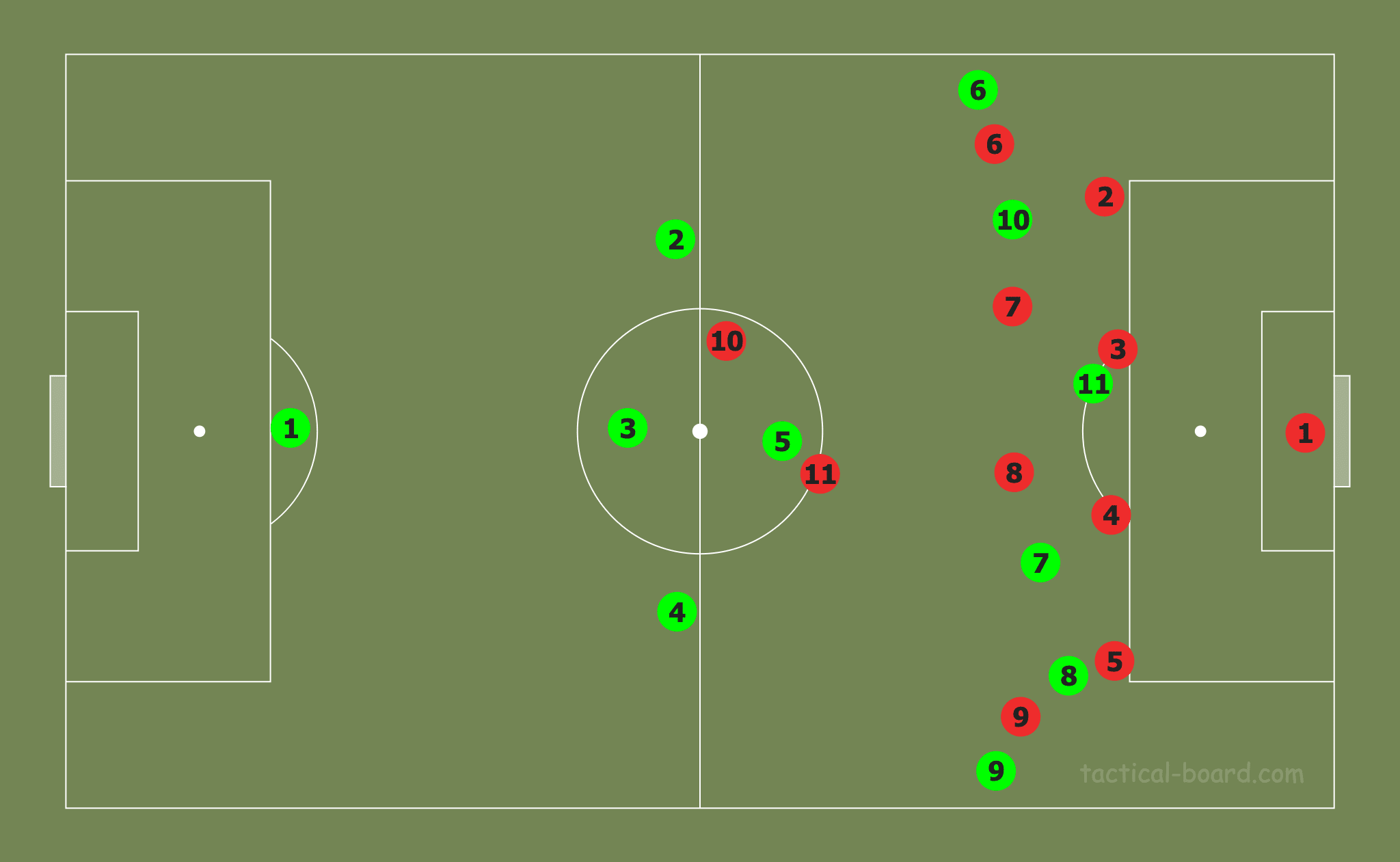
The role’s of the inside forwards are the most intriguing in this system. Harder and Popp are tasked with identifying space to be most effective. This is where Harder specifically is able to strive. Her intelligence is reading the game and playing multiple steps ahead of the opponent allows her to be dangerous. Her movement off the ball is the biggest factor in the stunning statistics she averages in this Wolfsburg side. She usually looks to occupy the pockets of space in between the defensive and midfield lines of the opponent within the half-space. This area gives her a variety of options to look to help her side break down their opponent.
The first benefit of occupying this space is presenting passing options for their defensive and build-up structure. These inside channels are frequently used to break down the opponent on the inside, which forces them to try and react and collapse centrally to prevent being exposed in this area. However, this is where Wolfsburg’s overload on the front line comes to prominence, as they give themselves plenty of options to move out wide and attack from these areas.
Head-to-head breakdown
Given the two club’s history with playing against one another in recent years, there is plenty of information when it comes to looking at the clubs head-to-head. For this tactical analysis, I took an in-depth look at two of the more recent matches between the two. The first match we will be looking into will be the 2018 Women’s UEFA Champions League Final, where Lyon came out victorious 4-1 after extra time. The second match is the first leg of the 2018-19 quarterfinals in Lyon in which the home side took a 2-1 advantage into the second leg. The two matches offered a different contrast in Wolfsburg’s approach that will allow us to see a variety of tactics used by the German side and the success it had or did not have.
In the 2018 Final, the scoreline offers a poor reflection of the match itself. The two giants of women’s football were deadlocked for the entirety of normal time, with Wolfsburg holding resolute to keep the match scoreless. Less than three minutes into extra-time we saw Wolfsburg’s hard work pay off with a deflected goal from Harder putting them ahead. Shortly after, Popp was sent off with her second yellow and the mix of being down a player and tired legs was too much for Wolfsburg, as they crumbled into conceding four.
The issues for the German side came in the attacking phase of the match. While their defensive stood resolute, the attack was unable to get a foothold in the game due to their deep nature while defending. This forced a couple of things to occur. With the back four staying in deeper positions along with the midfielders, they did not have the same forward options and outlets that they are accustomed to in the majority of their matches. With the combination of Harder and Popp typically along with the wingers moving around at times, there is constant movement up top in Wolfsburg’s system for one of the players in the initial build-up to find with a pass through the midfield line of the opponent.
With the more reserved approach, undoubtedly to protect against the possibility of a turnover and resulting counter-attack, they struggled to move forward into the middle and final third. This forced the German side into playing long balls in hopes that Harder or Pajor could win possession and hold it long enough to allow the rest of the side to progress forward. Against players such as Wendie Renard in defence though, Lyon’s dominance in the air made this tactic extremely ineffective.
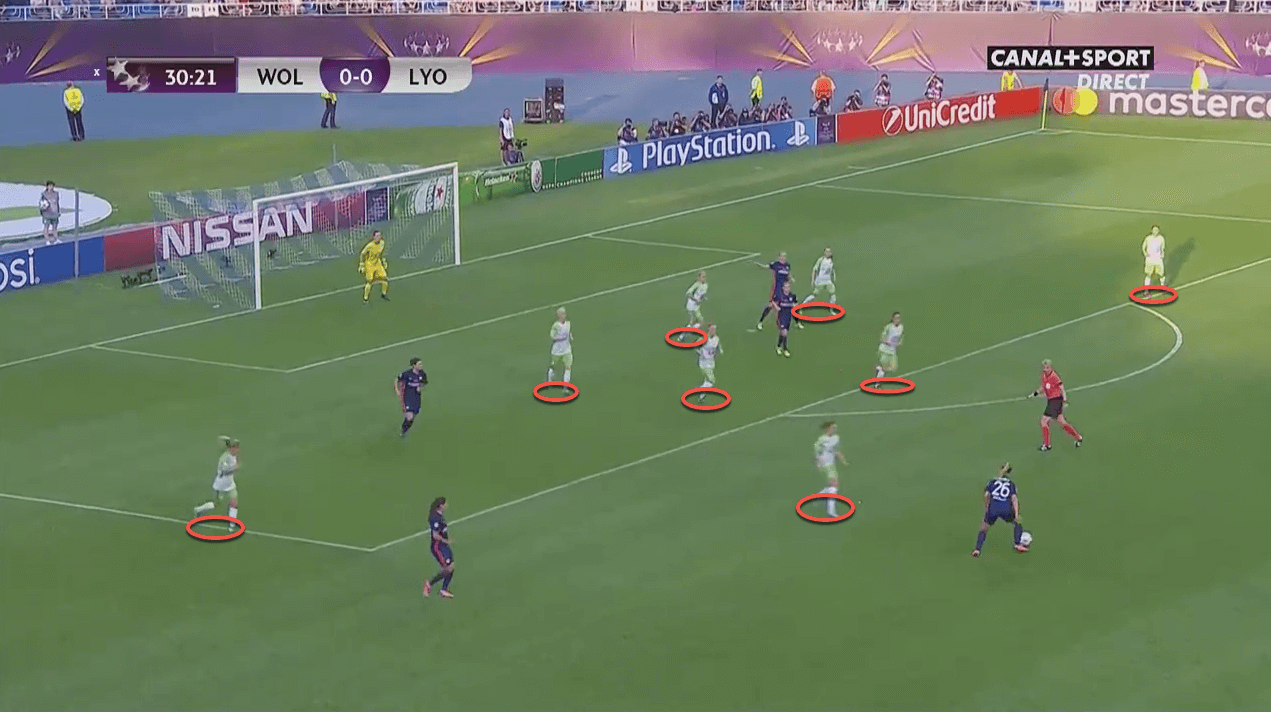
In the image above, Lyon is pressing in attack and looking for a way through Wolfsburg’s defensive structure. As possession pops out to the edge of the box, you can see that everyone with the exception of Harder and Pajor are in or just outside their own penalty area for the German side. While this makes it difficult for Lyon to create a dangerous opportunity on goal, it can also limit Wolfsburg’s ability going forward.
An attempted cross from the situation we see results in the goalkeeper coming out to collect with ease. As Wolfsburg look to transition to the attacking phase of their game, she tries to punt the ball forward to one of the attacking players. In the image below, you can see Pajor looking to win this ball in the air against both of the Lyon centre-halves. Even if she were to win this aerial duel, the attacker has no teammate around her to help win the second ball as the team had been so deep for Lyon’s attack. This theme was constant throughout the match and was a major reason why Wolfsburg were limited to an expected goals amount of 0.99.
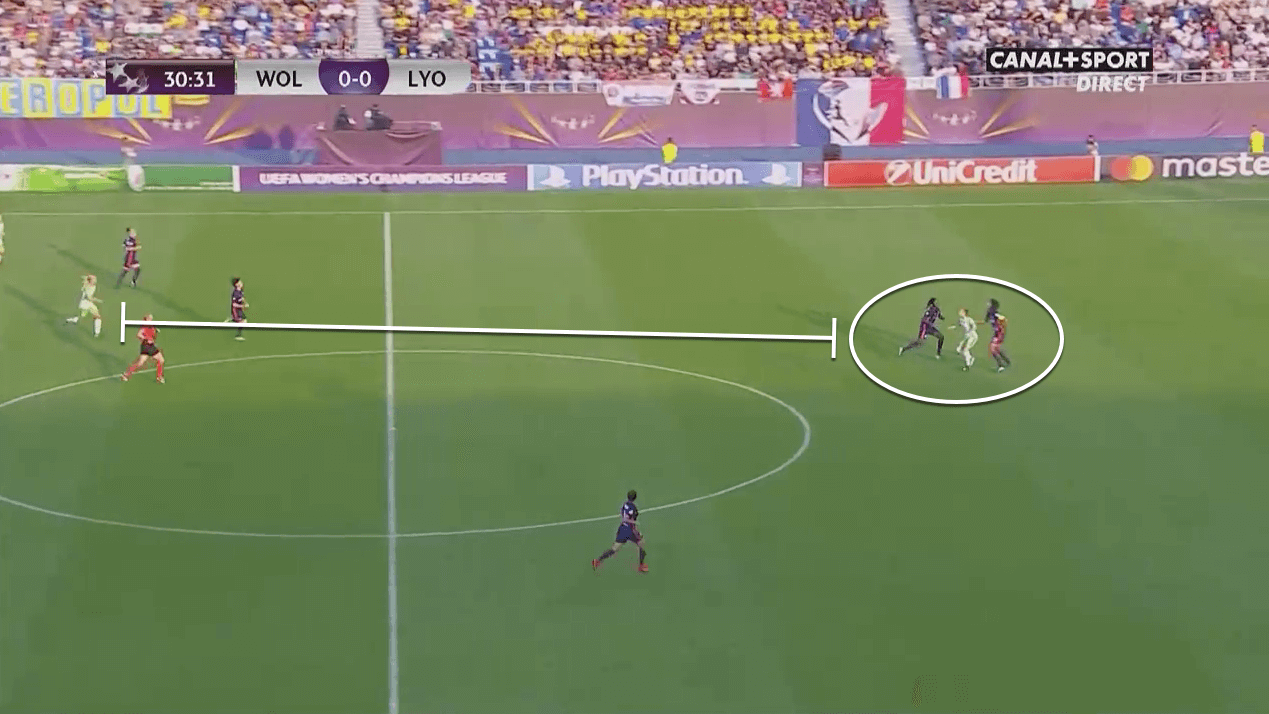
However, this match offered a great view of the tactics Wolfsburg use in their defensive orientation. As we mentioned in the section above, the German club lined up in a 4-4-2 set up. Harder lined up directly in line with Pajor for the majority of the match and they had one task: limit the supply into Lyon’s midfield players. This was largely done to great effect. Most of Lyon’s build-up was forced to go out wide before they were able to look to come back into their midfield pivot, which is so pivotal to the way they play and go forward.
The midfield and defensive lines sat deep for Wolfsburg. Their goal in this was to limit the French side when possession came into Wolfsburg’s defensive third. They were completely content with Lyon controlling possession in the middle third of the pitch for the majority of the match and left a large share of the pressing to the front two. The midfield four kept a short distance between themselves and the defensive line. When possession went into the full-backs, the outside midfielder would go out to mark them, but once again, the press did not really intensify until Lyon had progressed into the final third.
Using these tactics, Wolfsburg were able to nullify the majority of Lyon’s threat in this match. Because of the focus on clogging up the centre of the pitch, Lyon worked out wide. Wolfsburg’s deep starting position while defending meant that they were unable to find a lot of space in behind though. This resulted in the wingers and full-backs sending crosses into the box, which Wolfsburg’s centre-halves were more than comfortable in dealing with throughout the match.
The second match offered a bit of a different dynamic. It must be mentioned that the major contrast in approach to this match will have a part to do with the beginning of the match. A poor back pass after 13 minutes allowed Lyon to go ahead and they were able to double their lead before 20 minutes off of a corner. This being said, Wolfsburg were forced to come out of any shell they might have planned to be in to try and get back into the tie. However, even before this, there were signs of the change in approach we will look into from this match.
The most notable alteration to Wolfsburg’s set up came from their acknowledgement of their shape being too deep in the previous year. In this match, Wolfsburg continued to look to stay compact in the centre of the pitch when defending but would spread the pitch more when possession moved out wide or was regained. Spreading out the pitch forced Lyon to expand as well in their press, which allowed the German side to build out from the back more effectively. In the image below you can see Wolfsburg in this phase of their play moving possession out wide.
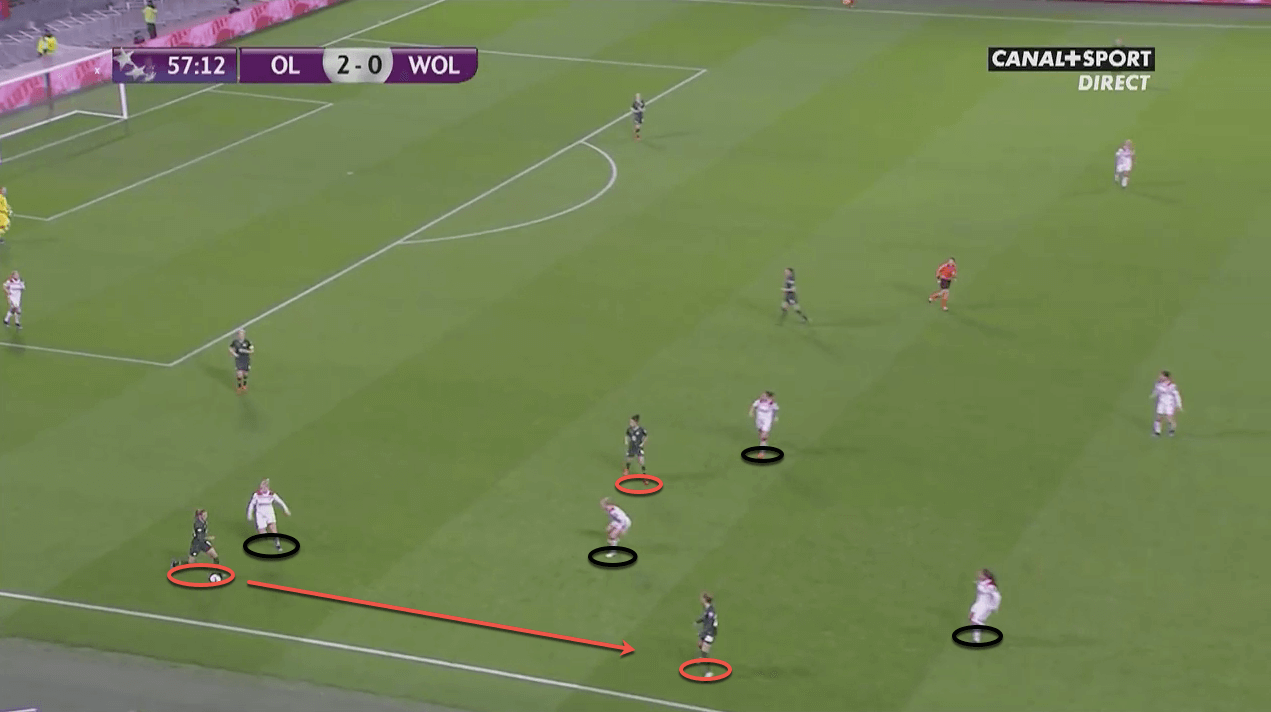
Acknowledging the press moving over into this area, the right-back plays a quick pass forward to her outside midfielder before moving inside away from her marker. She immediately gets the ball returned to her and moves it on to the left side of the pitch. Here you can see the open space Wolfsburg have to work with after playing through this press by expanding the pitch by using the width.
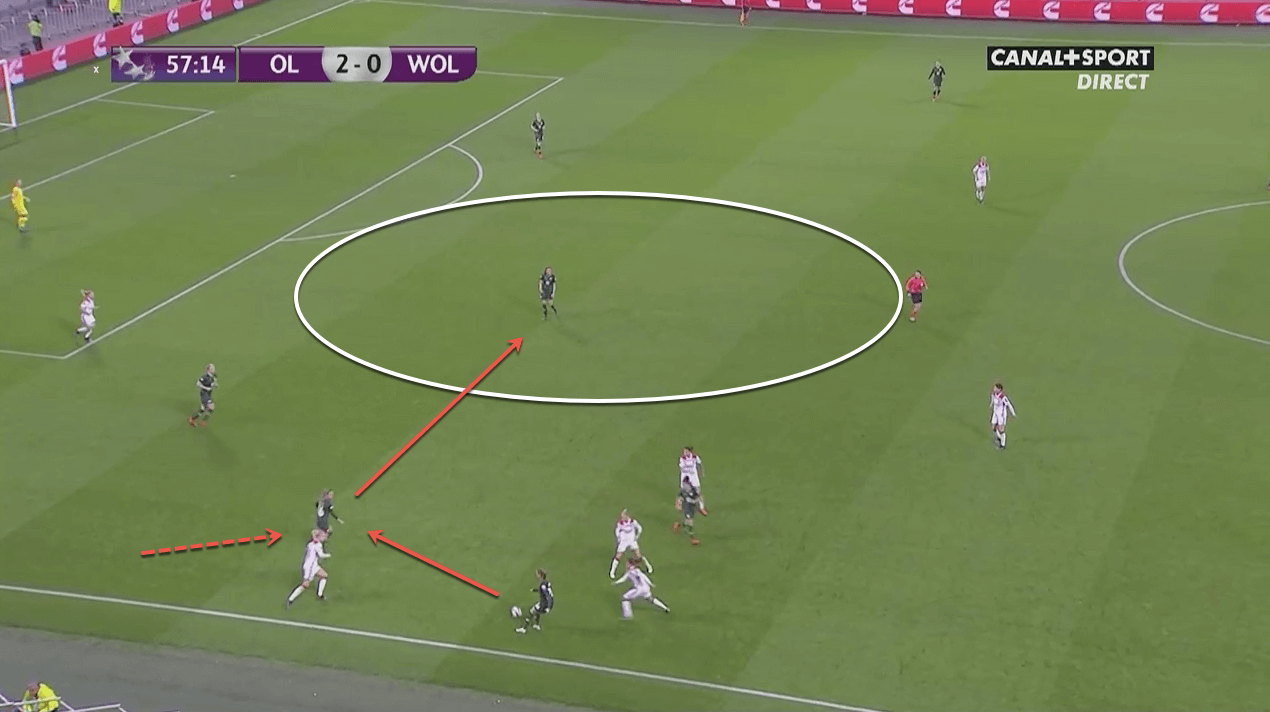
One of the biggest differences between the two games was Wolfsburg’s attacking shape. In the first match we looked at, they were extremely timid when it came to getting forward. Normally Harder and Pajor were tasked with creating the majority of their attacking intent through counter-attacking moves. In this match, however, Wolfsburg looked to keep a connection between the side and these two forwards, which came in the form of Sara Gunnarsdottir. With Wolfsburg’s typical attacking midfielder playing at off of the left side in this match, Gunnarsdottir took the role of getting forward in possession to help press the defensive line of Lyon. This different dynamic forced Lyon’s midfield to alter their approach. Rather than being able to solely look to block off passing lanes into Harder and Pajor as they were able to do in the 2018 final, they now had to look to do this while occupying Gunnarsdottir and others. You can see this in the image below. Wolfsburg have set up in a 2-3-5 shape and are forcing the Lyon defence to stay back and not restrict space, as well as pinning the holding midfielders by forcing them into trying to deny service into this area.
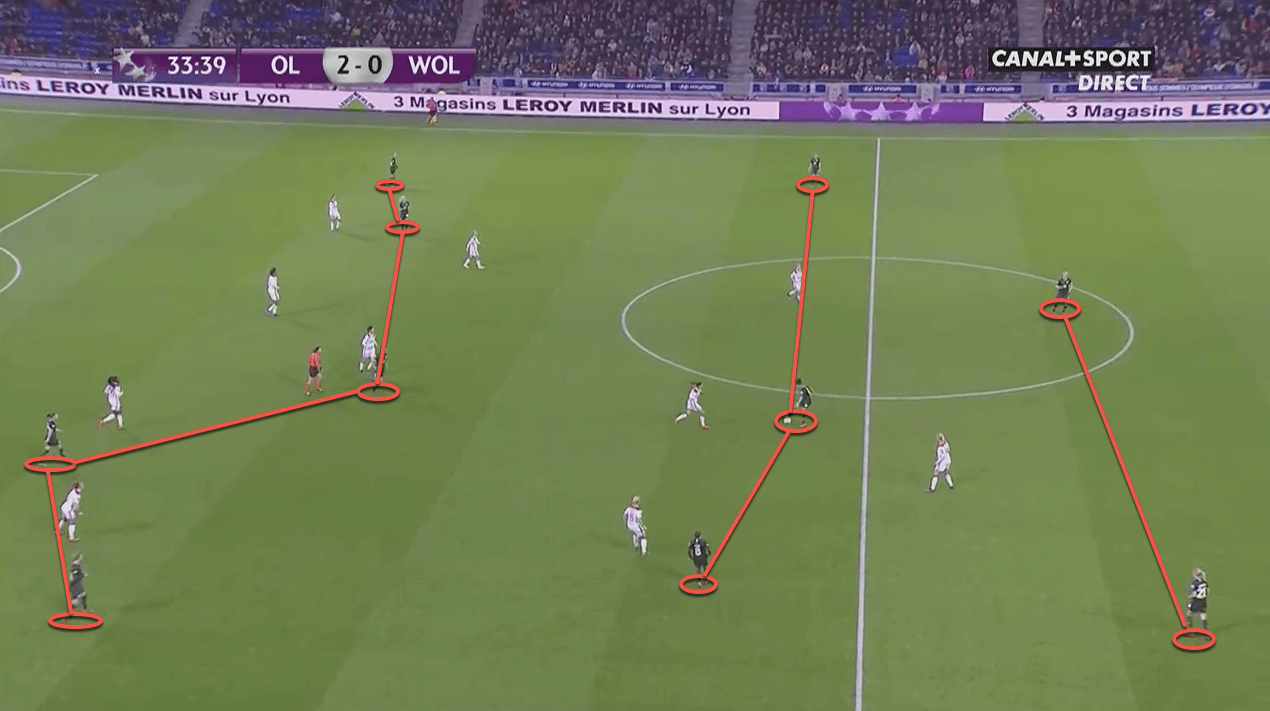
This alteration was accompanied with a greater focus in general of getting more players forward into central positions. We began to see Wolfsburg’s extremely attacking formation in possession with a player, in this instance it was Claudia Neto, controlling play from directly in front of these defenders. This shape forced Lyon to have to put emphasis on the central area. Wolfsburg were quick to adapt to this, however, and would normally look to play in to out. Here the wingers or full-backs were being left in one-v-one scenarios with Lyon’s outside backs.
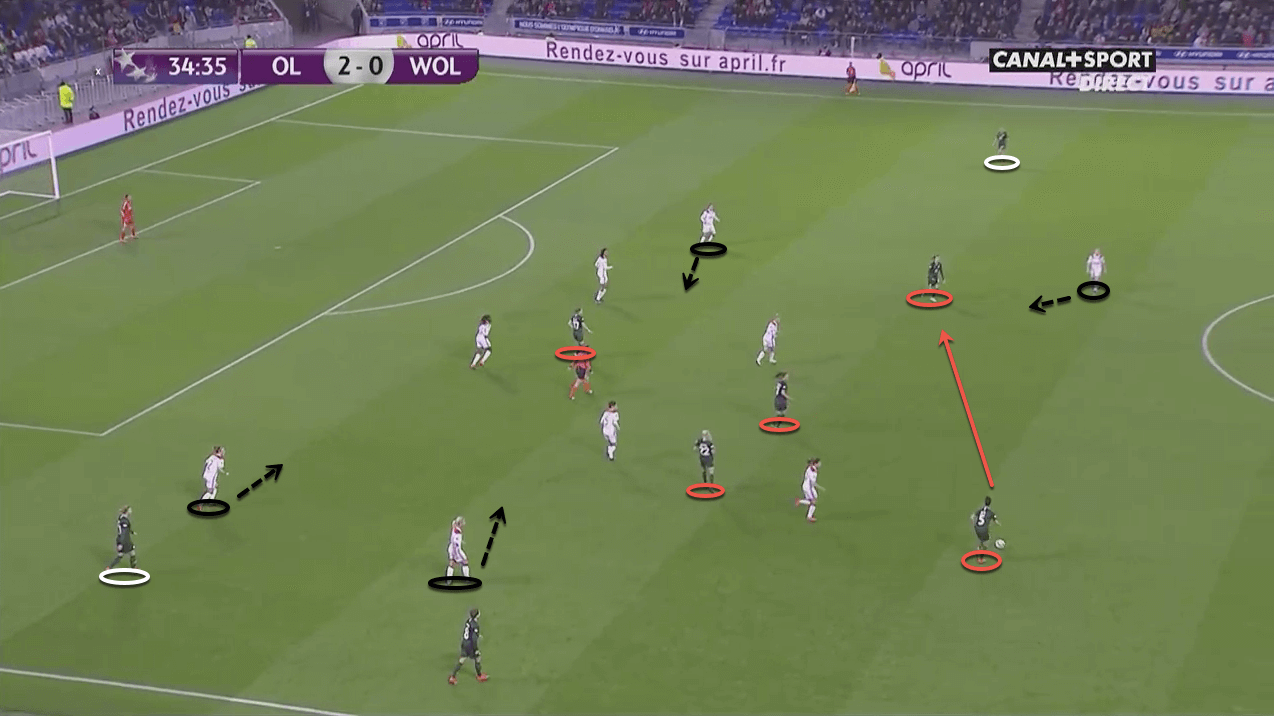
In the image above you can see Wolfsburg working this possession on the inside. Once space is identified to move forward, Lyon reacts by looking to restrict this space by becoming very compact. Quickly a pass is released and it comes out to the left side as you can see below. Notice particularly the space Wolfsburg have on either side of Lyon’s defensive shape in this image. Here the player in possession could look to play a cross into space behind the centre-halves for one of Harder or Pajor to get on the end of.
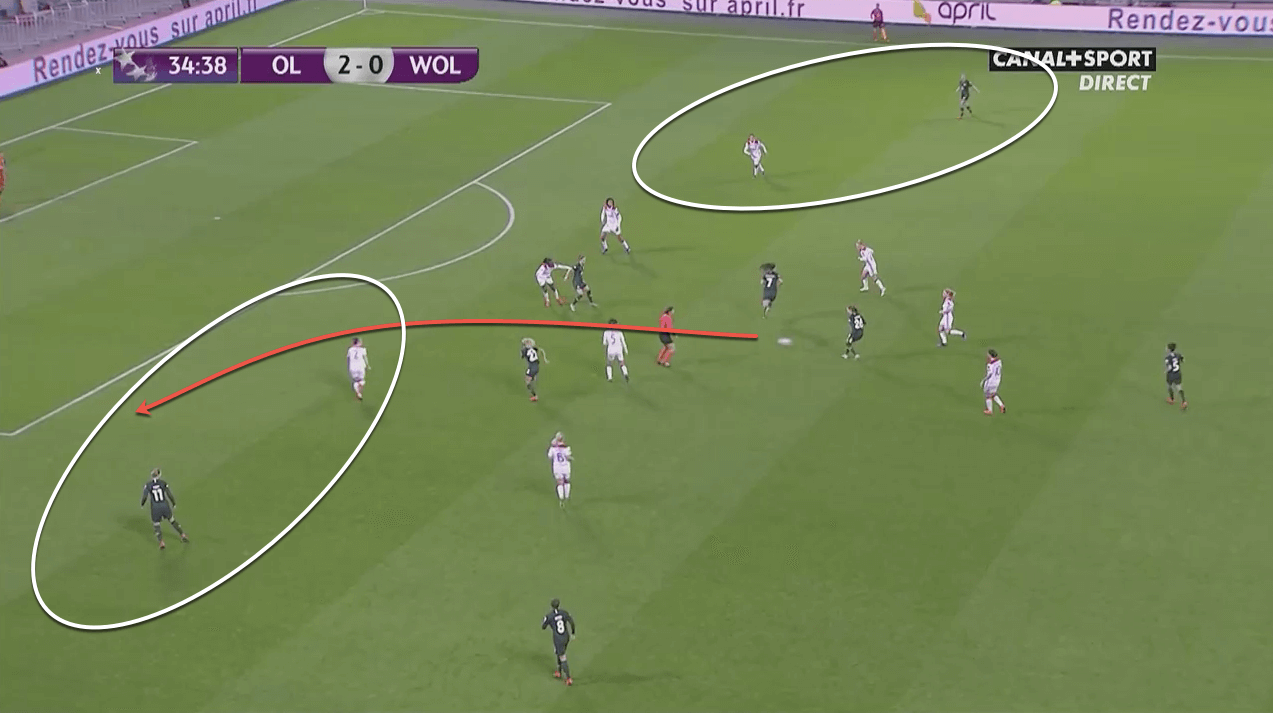
Wolfsburg’s greater success moving forward in this second match can be shown in the statistics. In the 2018 final, the German side completed 56.6% of their passes into the final third, and 64.65% of their progressive passes attempted. In this match, these success rates improved to 61.9% and 70.59% respectively. Both of these jumps represent a better ability from Wolfsburg in progressing play up the field and into opportunities to create chances against Lyon.
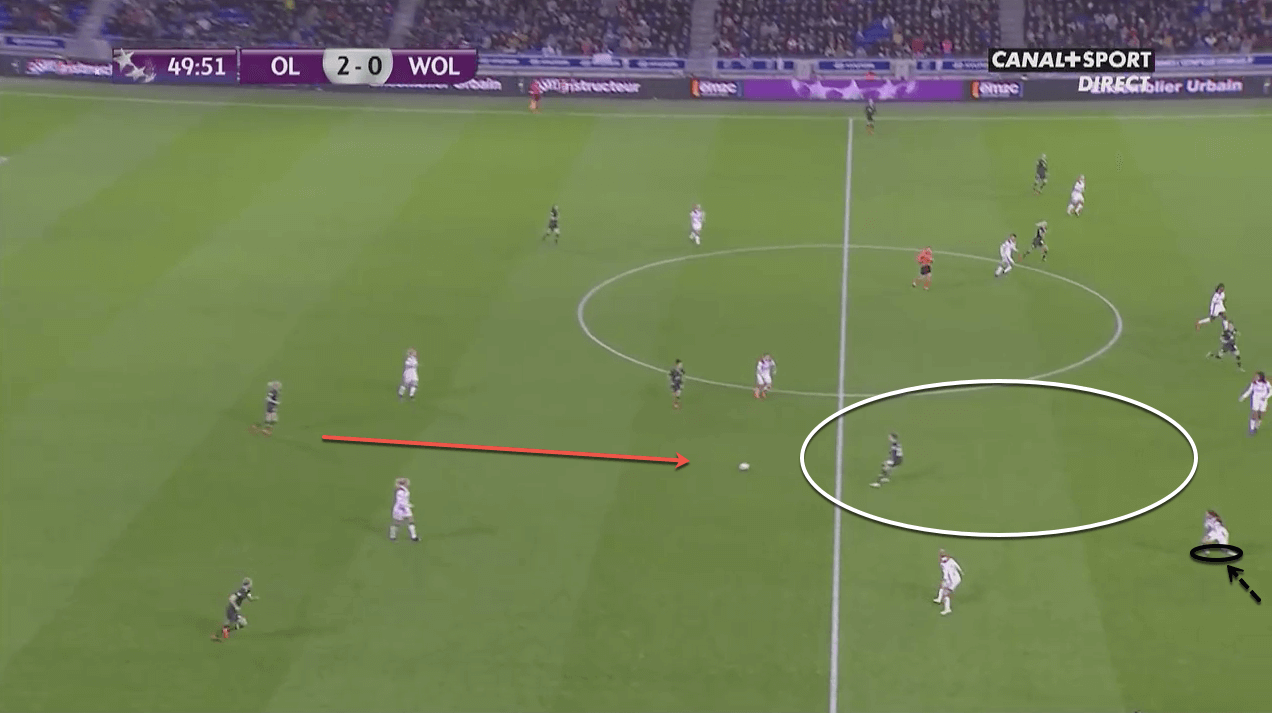
In the image above you can see these principles in action. Caroline Hansen is occupying the half-space in Wolfsburg’s attack and recognises the space she is in. She drops in to show for a passing option and is found by her centre-half. The Lyon full-back sees this an instinctively moves inside to the ball.
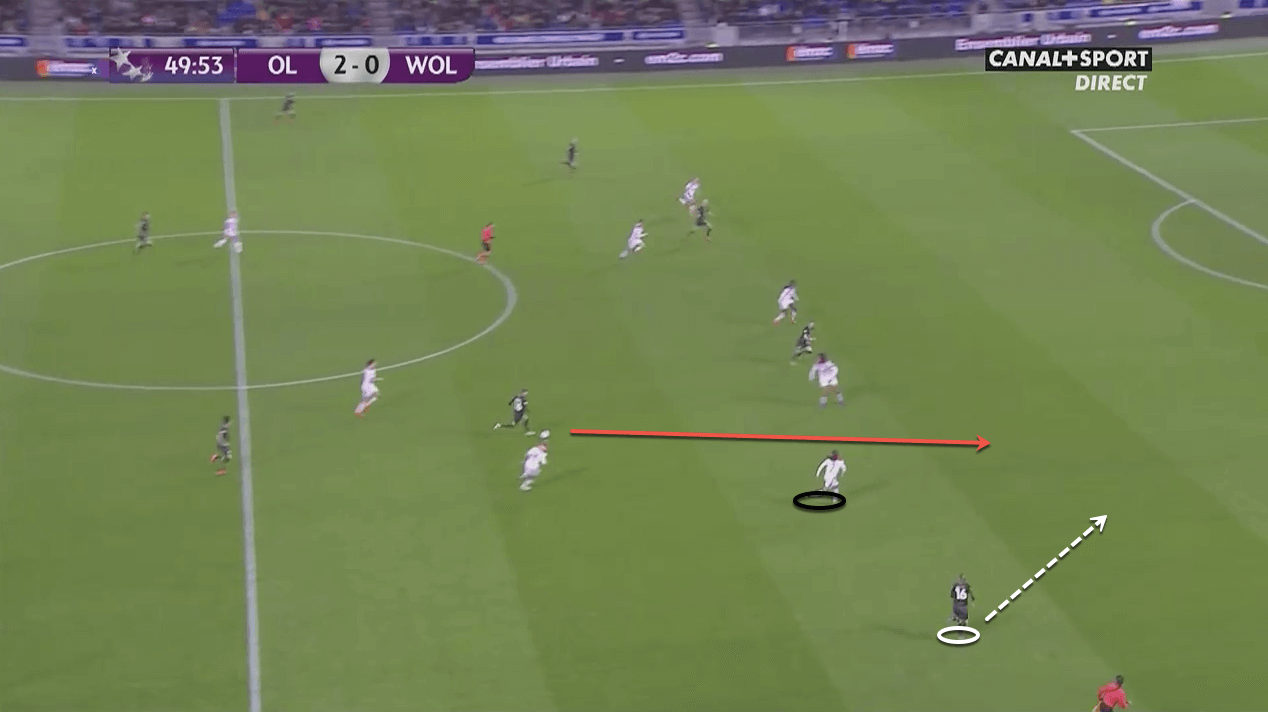
After beginning to make this movement, she realised that Noelle Martiz is making an overlapping run in the wide channel. Quickly the defender attempts to correct her mistake but Hansen is able to turn in possession and identify the passing lane in the space between the centre-half and full-back.
Defensively there were alterations in the set-up as well, which came mainly in the roles of the strikers. Instead of pressing higher up the field on the centre-halves, Pajor and Harder allowed them to have possession and put their focus more towards blocking off the midfield pivot of Lyon.
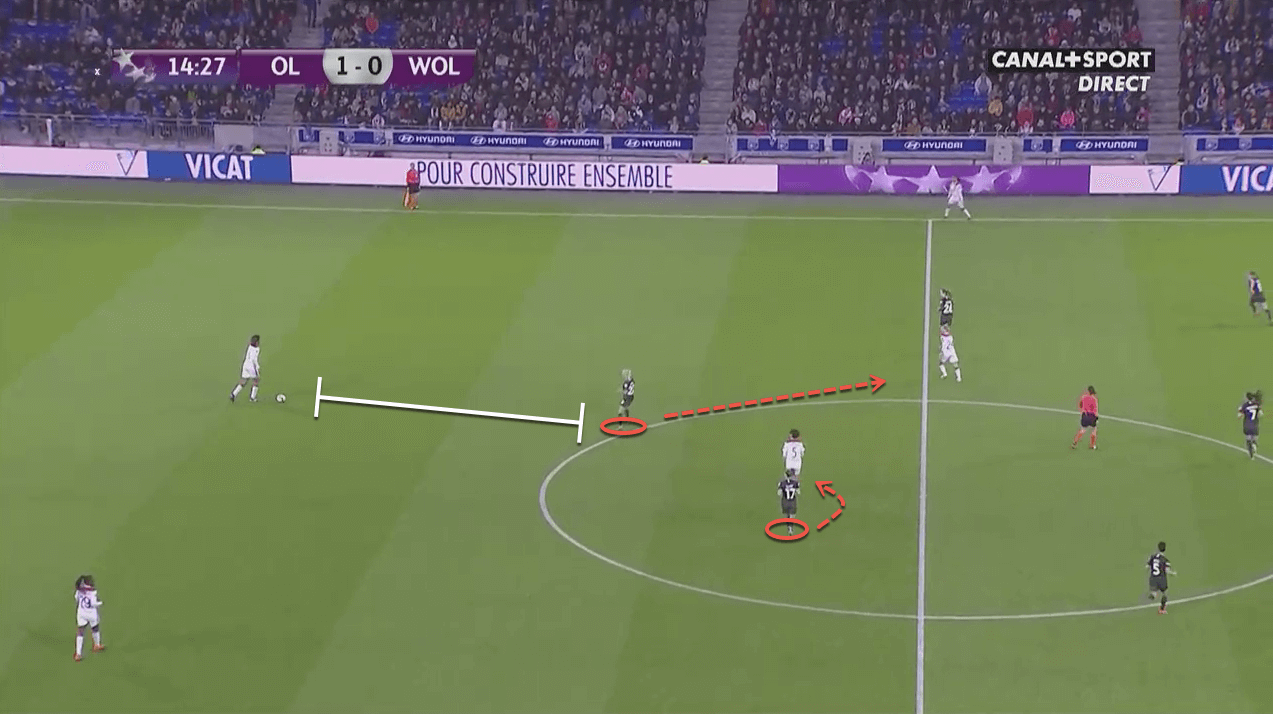
You can see this in the image above. Pajor is the deeper of the two as she is on the opposite side of the ball. Instead of pressing towards these two centre-halves of Lyon, they are staying in to hold the midfielders. This gives more assistance to their midfielders, who are able to give assistance in other areas of the pitch with the help of the strikers with these players.
Future tactical alterations and improvements
Taking both matches into consideration, there are positives and negatives to be associated with both. In this section, we are going to take a look at how Wolfsburg could look to set up on the offensive and defensive side when the two sides come head to head again.
Beginning on the defensive side, Wolfsburg have looked relatively sound despite some of the big numbers Lyon have managed to put past them in recent matches. Their structure with two banks of four defending compactly worked extremely effectively. As we mentioned in the section above, the biggest flaw with their defensive set-up in the 2018 final was the deepness in which they utilized it in. Having altered that, they altered this and put more pressure on Lyon higher up the pitch. To show this, in the 2018 final Wolfsburg managed 90 recoveries of the ball. Of these, 55 came from deep positions close to their box, and only 6 coming high up the pitch. In the first leg of their 2019 quarterfinal, they managed 88 recoveries. Only 35 came in these low areas, with 18 being higher up the pitch. This more aggressive defensive approach allowed them to have more control of the game, and it showed in the possession statistics. In the first match we looked at the German side held just over 52% possession, but in the second match, it was up to over 60%.
Having Harder and Pajor dropping deeper during the defensive phase was a positive decision from the German side. As we spoke on earlier, their presence occupying the space around Lyon’s holding midfielders was crucial in breaking up any rhythm they tried to create for their side. It also gave Wolfsburg’s midfielders more freedom to assist in other areas of the pitch. In the image below you can see an example of Lyon’s build-up in the 2018 final. Here you can see the high positioning of Harder and Pajor. Harder identifies the space in behind and signals for it to be covered but the midfield line is too deep to cover the gap and Lyon are able to expose the space and make Wolfsburg’s first line of press almost meaningless as the French side are now able to run forward at Wolfsburg’s defensive structure.
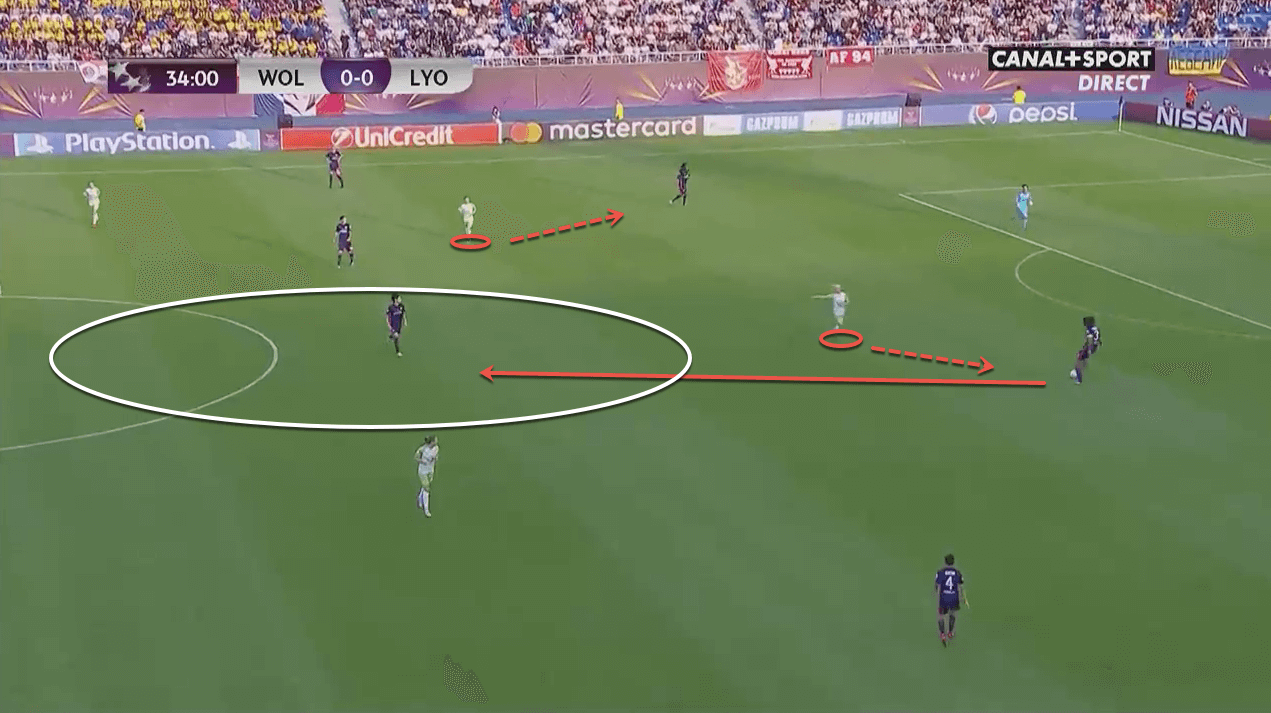
Harder’s positioning here could also be more effective in terms of Wolfsburg’s build-up. Identifying the room in the centre of the pitch that was left open due to Lyon’s higher press against Wolfsburg’s defensive line, specifically when possession was moved to one of the full-backs, taking Harder and adding her into the midfield to help progress play would allow Wolfsburg to be more stable in looking to establish their possession game and force Lyon to come away from their press and move into their defensive shape.
In the attacking phase, there were a host of improvements between the two games, and they revealed some further tactics Wolfsburg can further look at. As we detailed in the section above, their build-up into the attack in the second match was much improved and led to some favourable situations. The final ball is the place where they lacked the most. Despite a respectable 41.1% success rate in the first leg of last season’s quarterfinals, completing 7 out of 17 attempts. However, the majority of these did not lead to dangerous chances.
Looking at the two sides head-to-head, there are a couple of areas Wolfsburg can look to try and improve upon in the final third. Lyon are willing to allow sides more space out wide than in the centre of the pitch. Therefore, when possession is moved into these wide areas, it is imperative that the central players move off the ball to create room for themselves, specifically in behind the Lyon defence. As we have mentioned previously, Lyon are dominant aerially, enough so that it makes crosses and long passes in the air largely ineffective. Alternatively, Wolfsburg’s wide players can be looking for low crosses across the face of goal right in behind the defensive line. This type of cross is extremely difficult to defend against. It forces defenders to turn their orientation to face their own goal making it imperative that their attempted clearance is spot on and does not end up going towards their own goal. On the attacking side, this compliments the Wolfsburg forward players well. Pajor is one of the most dangerous strikers in the world, and her ability to move in and around defenders in the penalty area is one of her biggest assets. Harder is at her best off the ball, using her intelligence to read the game multiple steps ahead of what is happening and find time and space to help her side. If both look to get on the back shoulder of each of the centre-halves when possession is moved out wide they could be very dangerous in these types of situations. You can see an example of this movement in the image below. Possession is played from inside to out and as Lyon try to expand their defensive structure, #8 provides a cross on the floor for #10 and #11 to get onto as they look to make runs off the backs of the centre-halves.
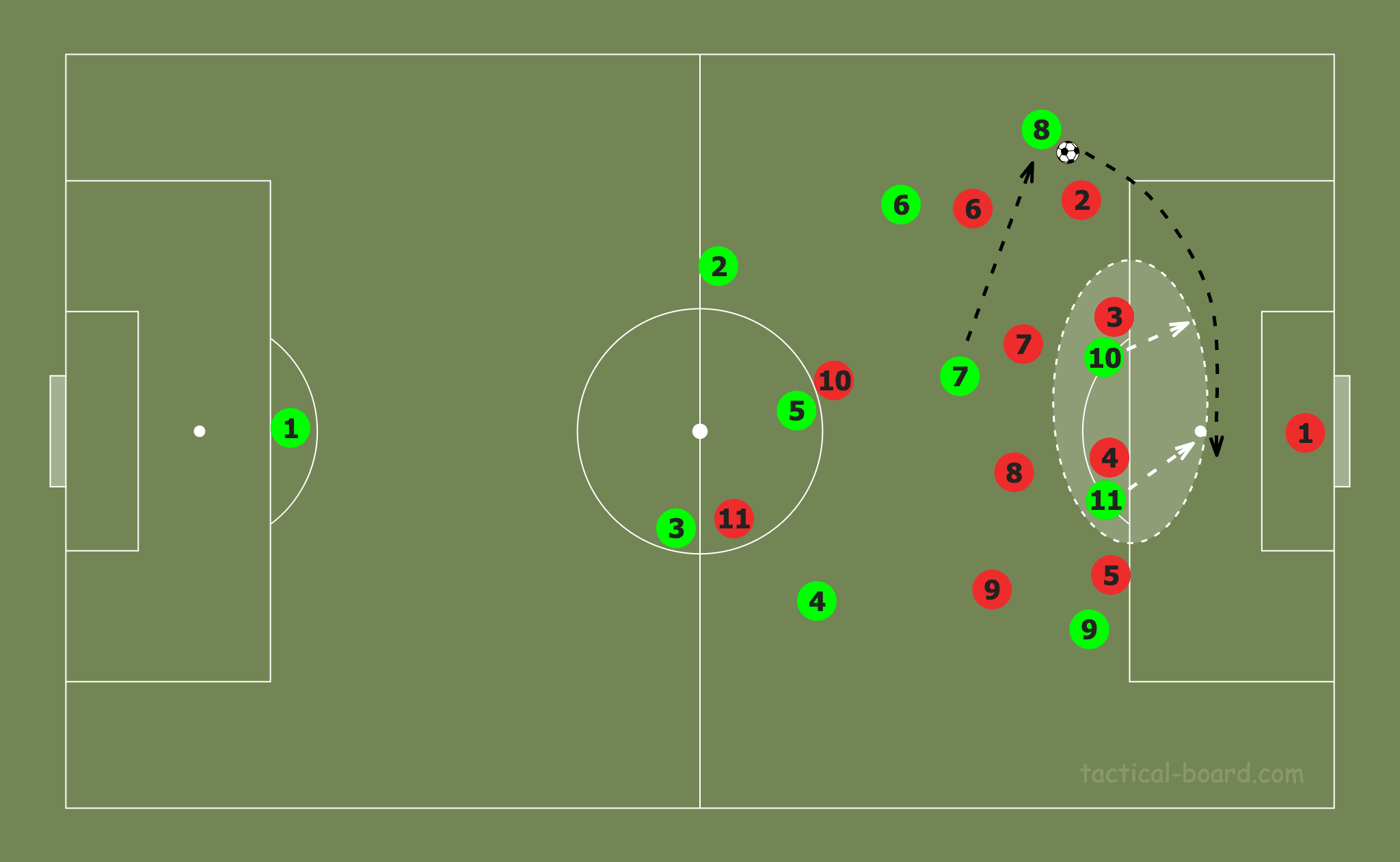
These two have the ability to make life extremely difficult for Lyon’s centre-halves. Harder, in particular, has the speed to get in behind the defensive line as well. This could be used in situations further away from goal, but would still need to be achieved with passes on the floor. Countless times in previous matches we have seen balls been played over the top that have resulted in easy interceptions by the Lyon centre-halves. Here, rather than looking to play off the back of the centre-halves, the likes of Harder or Popp, who occupies a more attacking position when in possession, can look to make runs in and across the front of the centre-halves and into the half-spaces. This creates a difficult situation for these defenders, as if they decide to follow these runs, it opens up space for the likes of Pajor to make a run in behind or show for a pass to move possession forward into an advanced position.
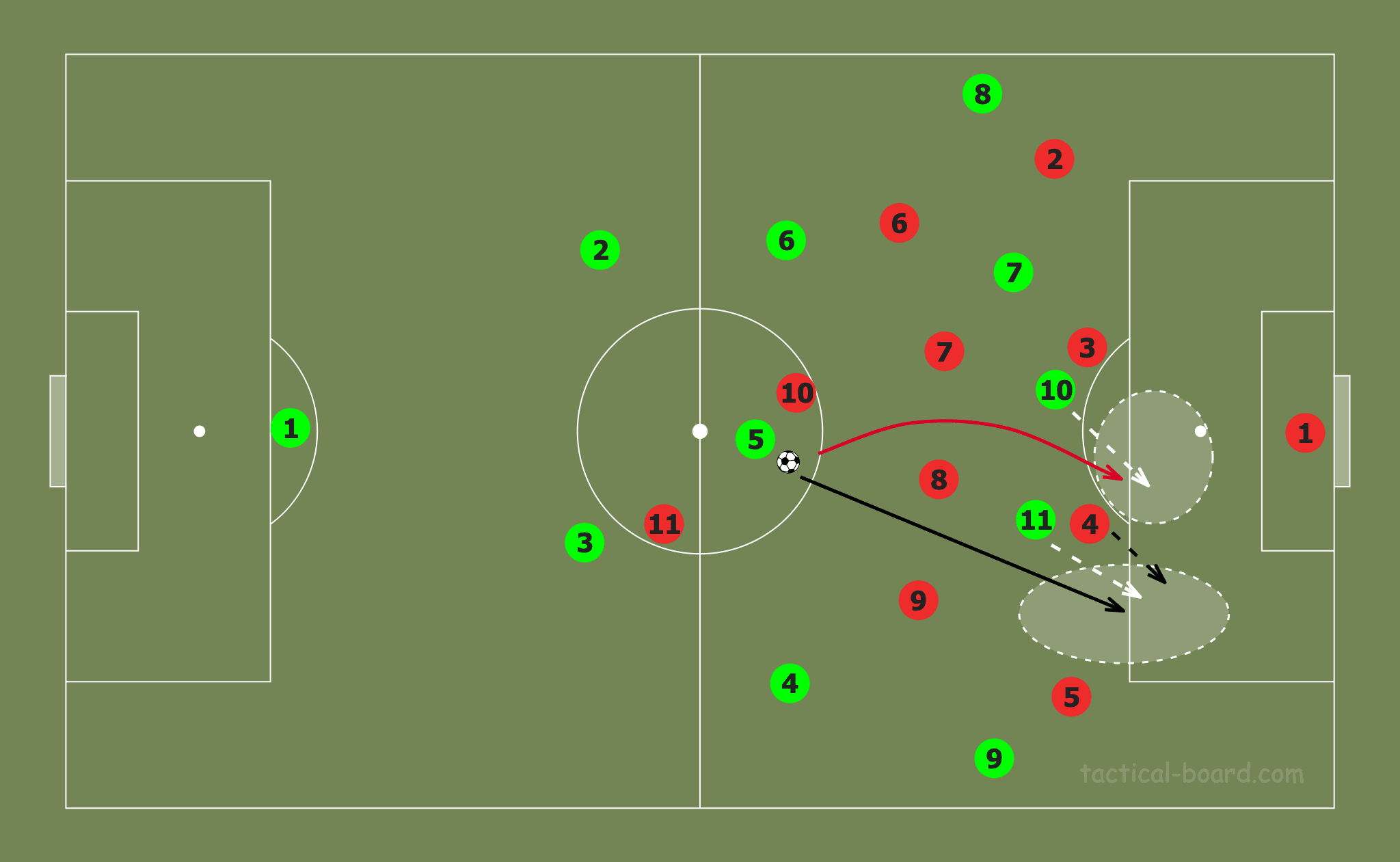
In the image above you can see the movement of these inside forwards opening up a number of attacking opportunities for the German side. If #11 moves into this channel she makes herself a passing option in behind. However, if the centre-half follows her, it opens up a huge gap for #10 to move into behind the defensive line.
Conclusion
While Wolfsburg have found themselves on the losing side in every encounter between them and Lyon, the level between the two sides is not as far as it may seem. A red card effectively settled the 2018 final, while a sloppy back pass changed the entire dynamic of the tie last season. Between both matches, Wolfsburg have shown that they can effectively defend and attack Lyon.
In this scout report, we have looked at this matchup between two of Europe’s heavyweights. Focusing on Wolfsburg, we have identified areas in which they have struggled in recent years against Lyon in particular. With this, we can see the possibilities they have to improve and look to finally get the better of their rivals by doing so.
In the coming years, Wolfsburg will look to continue to improve in all areas of their game, and given the dominance they showed throughout the season before it was suspended, challenging Lyon for their spot at the summit of European football is a very real possibility. If the streak continues of the two sides coming head-to-head in Europe, it will come this season in the final once again.






Comments